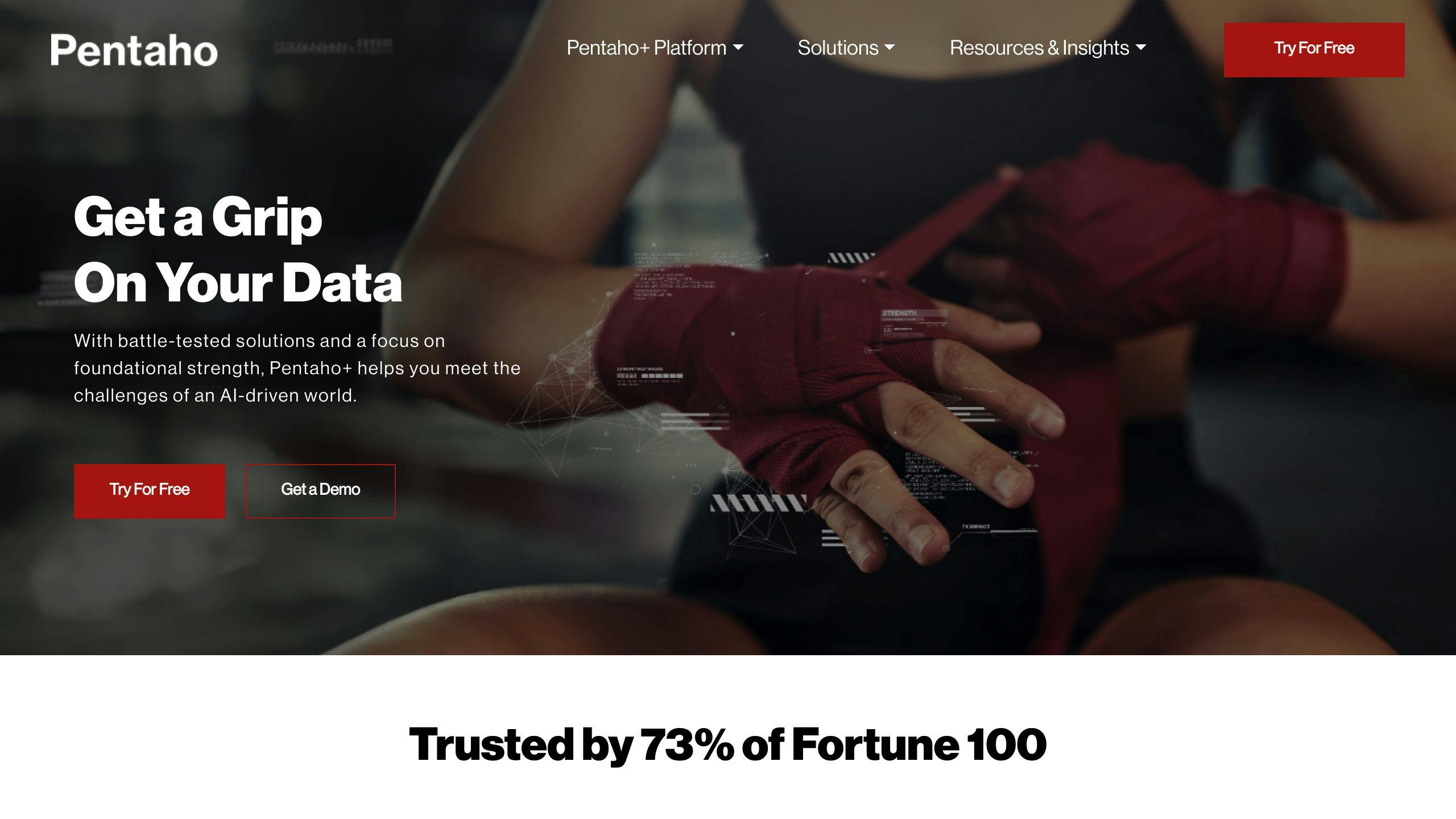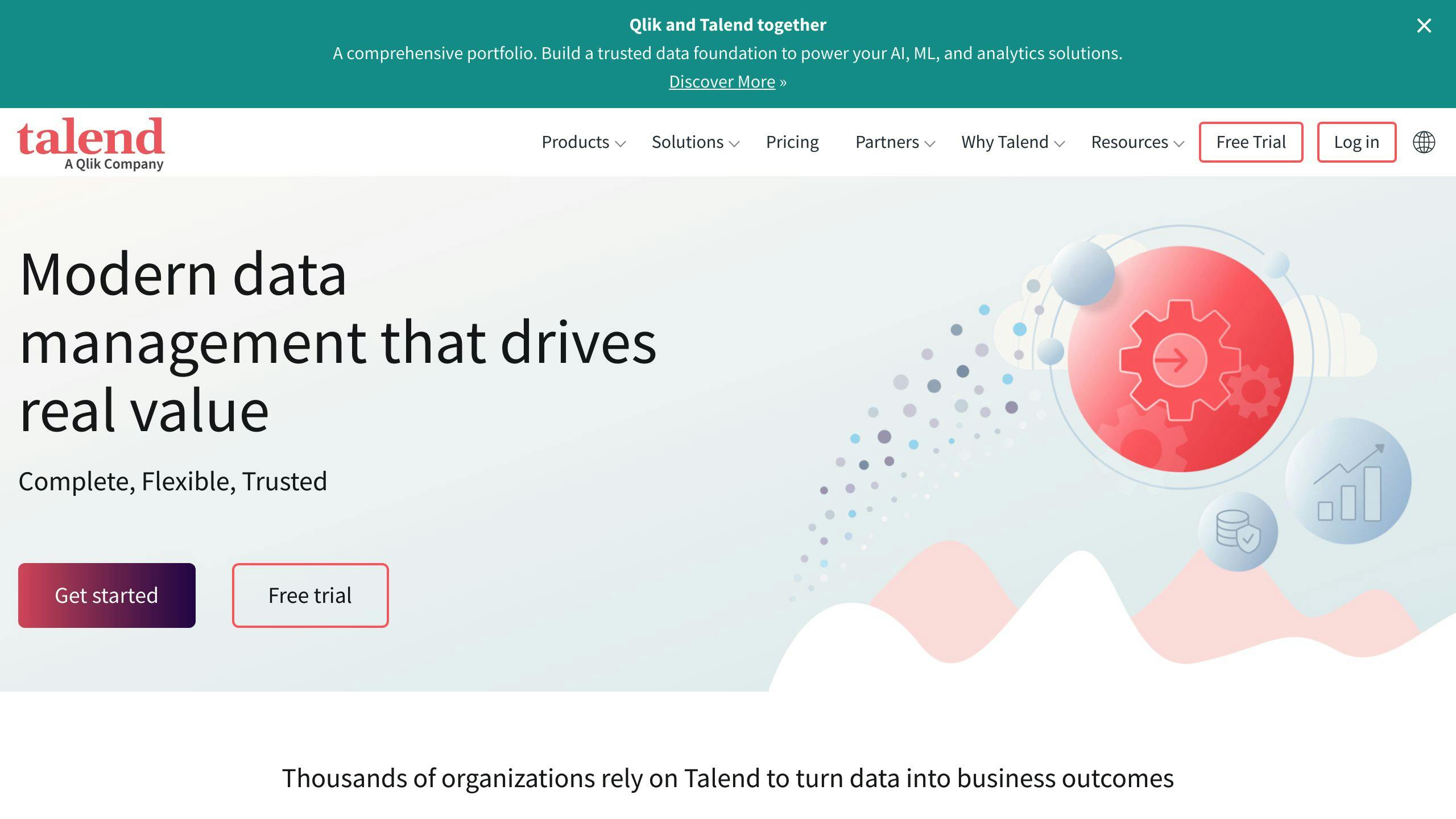Pentaho and Talend are leading open-source data integration and ETL (Extract, Transform, Load) tools that help businesses combine data from multiple sources, transform it into a unified format, and load it into target systems. Both tools offer robust integration capabilities, but differ in their strengths and suitability for different use cases.
Key Differences:
| Factor | Pentaho | Talend |
|---|---|---|
| Usability | Easy to use, intuitive interface | Steeper learning curve, requires technical expertise |
| Scalability | Suitable for small to medium-sized projects | Handles large-scale data integration projects efficiently |
| Enterprise Features | Offers advanced data governance, data lineage, and data quality capabilities | Provides some enterprise features, but not as mature as Pentaho |
| Cost | Open-source version available, enterprise version pricing varies | Open-source version available, subscription-based pricing for enterprise version |
Quick Comparison:
| Feature | Pentaho Data Integration | Talend |
|---|---|---|
| Usability | Easy to use, intuitive interface | Steeper learning curve, requires technical expertise |
| Community Support | Large and active community, extensive resources | Strong community support, but slightly smaller |
| Integration Capabilities | Supports various data sources, including cloud and big data | Broad range of integration options, including real-time data integration |
| Scalability | Suitable for small to medium-sized projects, may slow down with large data volumes | Handles large-scale data integration projects efficiently |
| Enterprise Features | Offers advanced data governance, data lineage, and data quality capabilities | Provides some enterprise features, but not as mature as Pentaho |
| Cost | Open-source version available, enterprise version pricing varies | Open-source version available, subscription-based pricing for enterprise version |
The choice between Pentaho and Talend depends on your organization's specific needs and requirements, such as team expertise, project size, data governance needs, and budget.
Pentaho Data Integration Overview

Pentaho Data Integration is a powerful tool that helps organizations combine data from different sources, transform it into a unified format, and load it into target systems. This platform supports a wide range of data sources, including:
| Data Source | Description |
|---|---|
| Databases | Over 30 open-source and proprietary database platforms |
| Files | Flat files |
| Big Data Analytics | Integration and management of Hadoop data |
The platform offers a user-friendly interface, making it easy to design, test, and deploy integration processes, workflows, notifications, and alerts. Its graphical ETL designer enables data integration teams to:
- Create integration processes
- Test and deploy them
- Manage supporting metadata
Pentaho Data Integration is particularly suitable for large enterprises with complex data integration needs. It provides a centralized system for data aggregation, reporting, and analytics, making it an attractive option for companies seeking a single point of control.
Talend: An Introduction

Talend is an open-source data integration platform that offers a range of tools for data integration, data management, enterprise application integration, data quality, cloud storage, and Big Data. Founded in 2005, Talend has become a leading player in the data integration market.
Core Offerings
Talend's core offerings include:
- Data integration
- Data quality
- Big Data integration
Its flagship product, Talend Open Studio, is a popular open-source data integration tool that enables users to integrate data from various sources, transform it into a unified format, and load it into target systems.
Key Characteristics
Talend is known for its:
- Open-source nature, which promotes collaboration and innovation
- Community-driven approach, which has led to the development of a rich ecosystem of connectors, components, and plugins
- User-friendly interface and drag-and-drop functionality, making it accessible to users with varying levels of technical expertise
Business Scenarios
Talend is suitable for businesses with complex data integration needs, particularly those that:
- Handle large volumes of data
- Require real-time data integration
- Need advanced data quality features
- Leverage cloud computing and Big Data analytics
In the next section, we will compare the user-friendliness of Pentaho and Talend, examining their interfaces, ease of use, and learning curves.
User-Friendliness Comparison
When evaluating the user-friendliness of Pentaho and Talend, we can see that both tools have their strengths and weaknesses.
Interface Comparison
| Tool | Interface |
|---|---|
| Pentaho | More user-friendly and intuitive |
| Talend | Requires more technical expertise |
Pentaho's interface is generally easier to navigate, making it a better option for non-technical users. Talend's interface, while still user-friendly, requires more technical knowledge to use effectively.
Community Support
| Tool | Community Support |
|---|---|
| Pentaho | Larger and more active community |
| Talend | Strong community, but not as extensive |
Pentaho has a larger and more active community of users, which means there are more resources available for support and troubleshooting. Talend's community is still strong, but it may not have as many resources available.
Learning Curve
| Tool | Learning Curve |
|---|---|
| Pentaho | Easier to learn |
| Talend | Steeper learning curve |
Pentaho is generally easier to learn and use, especially for non-technical users. Talend, on the other hand, has a steeper learning curve and may require more training and support.
Overall, Pentaho is a more user-friendly option, especially for non-technical staff. However, Talend's steeper learning curve can be overcome with proper training and support, making it a viable option for organizations with more technical expertise.
Support and Community Resources
Both Pentaho and Talend offer robust support and community resources to help users get the most out of their data integration tools.
Community Forums
| Tool | Community Forum |
|---|---|
| Pentaho | Large and active community with a comprehensive forum |
| Talend | Strong community forum with clear categories and search function |
Pentaho's community forum provides access to a wealth of knowledge and expertise, with sections for general discussion, reporting issues, and requesting new features. Talend's community forum is well-organized, making it easy to find relevant information.
Documentation and Tutorials
Both Pentaho and Talend provide extensive documentation and tutorials to help users get started with their data integration tools.
| Tool | Documentation and Tutorials |
|---|---|
| Pentaho | Comprehensive user manual, getting started guide, and tutorials |
| Talend | Detailed user manual, quick start guide, and tutorials on data integration, big data, and cloud integration |
Professional Support
In addition to community support, both Pentaho and Talend offer professional support options for users who require more extensive assistance.
| Tool | Professional Support |
|---|---|
| Pentaho | Priority support, dedicated support engineers, and customized support plans |
| Talend | Standard support, premium support, and enterprise support with varying levels of support and service |
Overall, both Pentaho and Talend offer robust support and community resources that can help users get the most out of their data integration tools. While Pentaho's community forum may be slightly more extensive, Talend's professional support options are more comprehensive and flexible. Ultimately, the choice between Pentaho and Talend will depend on the specific needs and requirements of your organization.
Integration Capabilities
When it comes to integration capabilities, both Pentaho and Talend offer robust features to support diverse data integration needs.
Data Integration Features
Both tools provide a range of features to support data integration, including:
| Feature | Description |
|---|---|
| Data Migration and Synchronization | Move data between systems and keep it up-to-date |
| Data Transformation and Mapping | Convert data formats and map data structures |
| Data Quality and Governance | Ensure data accuracy and compliance |
| Real-time Data Integration | Integrate data in real-time |
| Cloud and Big Data Integration | Integrate data from cloud and big data sources |
Comparison of Integration Capabilities
While both tools offer robust integration capabilities, there are some differences:
| Tool | Integration Capability |
|---|---|
| Pentaho | Strong support for cloud and big data integration |
| Talend | Broader range of integration options, including real-time data integration |
Ultimately, the choice between Pentaho and Talend will depend on the specific integration requirements of your organization. If you need strong support for cloud and big data integration, Pentaho may be the better choice. However, if you require a broader range of integration options, Talend may be the better option.
sbb-itb-ceaa4ed
Scalability for Business Growth
Scalability is crucial for data integration and ETL tools, as it directly impacts an organization's ability to grow and adapt to changing data demands. Both Pentaho and Talend offer scalable solutions, but there are some differences in their approaches.
Talend's Scalability
Talend focuses on providing easy-to-use big data integration tools with high-performance integration code running natively on Hadoop. The platform has made significant performance improvements, including enhancements to the Talend Data Mapper, which can handle complex data structures. Additionally, Talend 5.5 has improved performance and scalability on Hadoop by an average of 45 percent.
Talend's scalability is further enhanced by its ability to handle real-time or operational big data, allowing companies to deliver analytics and recommendations to the right people at the right time.
Pentaho's Scalability
Pentaho also offers scalable solutions, particularly in the area of cloud and big data integration. The platform's data integration capabilities are designed to handle large volumes of data and scale to meet the needs of growing organizations.
Scalability Comparison
| Tool | Scalability Features |
|---|---|
| Talend | High-performance integration code on Hadoop, real-time big data integration |
| Pentaho | Scalable cloud and big data integration, handles large volumes of data |
While both tools offer scalable solutions, Talend's focus on real-time big data integration and high-performance Hadoop code gives it an edge in terms of scalability for business growth. However, Pentaho's strengths in cloud and big data integration make it a viable option for organizations with specific needs in these areas.
Ultimately, the choice between Pentaho and Talend will depend on the specific scalability requirements of your organization.
Advanced Enterprise Features
When it comes to advanced enterprise features, both Pentaho and Talend offer a range of capabilities to support complex data integration and ETL needs. Here, we'll delve into the specifics of each tool's offerings in areas such as data governance, lineage, and quality.
Data Governance
Data governance is critical for ensuring data accuracy, completeness, and compliance with regulatory requirements. Both Pentaho and Talend provide data governance features, but they differ in their approach.
| Tool | Data Governance Features |
|---|---|
| Pentaho | Robust framework, policy management, quality monitoring, lineage tracking |
| Talend | Governance module, quality, masking, encryption |
Data Lineage
Data lineage tracks data as it flows through systems and transformations. Both tools offer data lineage capabilities, but they differ in their approach.
| Tool | Data Lineage Features |
|---|---|
| Pentaho | Integrated with governance framework, comprehensive provenance tracking |
| Talend | Tracks transformations and movements across systems |
Data Quality
Data quality is critical for ensuring data accuracy, completeness, and consistency. Both Pentaho and Talend offer data quality features, including profiling, validation, and cleansing.
| Tool | Data Quality Features |
|---|---|
| Pentaho | Advanced quality rules, metrics, profiling, validation, cleansing |
| Talend | Profiling, validation, cleansing |
In conclusion, both Pentaho and Talend offer advanced enterprise features to support complex data integration and ETL needs. While both tools have their strengths and weaknesses, Pentaho's robust data governance framework, comprehensive data lineage tracking, and advanced data quality features make it a more attractive option for organizations with stringent data management requirements.
Cost and Pricing Models
When choosing a data integration and ETL tool, the cost of ownership is a crucial factor. Both Pentaho and Talend offer open-source versions, which can reduce costs. However, their enterprise versions come with a price tag. In this section, we'll explore the pricing models of both tools to help you make an informed decision.
Open-Source Availability
| Tool | Open-Source Version |
|---|---|
| Pentaho | Pentaho Community Edition (free, with core features) |
| Talend | Talend Open Studio (free, with limited data integration features) |
While these open-source versions can be a cost-effective option for small-scale projects or proof-of-concepts, they often lack the advanced features and support required for large-scale enterprise deployments.
Enterprise Pricing
| Tool | Enterprise Pricing |
|---|---|
| Pentaho | 30-day trial, then custom quote from sales team |
| Talend | 14-day trial, then subscription-based pricing (exact pricing not disclosed) |
In conclusion, when evaluating the cost and pricing models of Pentaho and Talend, consider your organization's specific needs and requirements. While open-source versions can be a cost-effective option, they may lack the advanced features and support required for large-scale enterprise deployments. Carefully evaluate the pricing models and support options before making a decision.
Detailed Comparison
When choosing between Pentaho and Talend, it's essential to understand their differences in various aspects. Here's a detailed comparison of the two data integration and ETL tools:
Comparison Table
| Feature | Pentaho Data Integration | Talend |
|---|---|---|
| Usability | Easy to use, intuitive interface | Steeper learning curve, requires technical expertise |
| Community Support | Large and active community, extensive resources | Strong community support, but slightly smaller |
| Integration Capabilities | Supports various data sources, including cloud and big data | Broad range of integration options, including real-time data integration |
| Scalability | Suitable for small to medium-sized projects, may slow down with large data volumes | Handles large-scale data integration projects efficiently |
| Enterprise Features | Offers advanced data governance, data lineage, and data quality capabilities | Provides some enterprise features, but not as mature as Pentaho |
| Cost | Open-source version available, enterprise version pricing varies | Open-source version available, subscription-based pricing for enterprise version |
This comparison table highlights the key differences between Pentaho and Talend, enabling you to make an informed decision based on your organization's specific needs and requirements.
Choosing the Right Tool
When selecting a data integration and ETL tool, it's essential to weigh the pros and cons of both Pentaho and Talend. Here are some key takeaways to guide your decision:
Key Considerations
| Factor | Pentaho | Talend |
|---|---|---|
| Usability | Easy to use, intuitive interface | Steeper learning curve, requires technical expertise |
| Scalability | Suitable for small to medium-sized projects | Handles large-scale data integration projects efficiently |
| Enterprise Features | Offers advanced data governance, data lineage, and data quality capabilities | Provides some enterprise features, but not as mature as Pentaho |
| Cost | Open-source version available, enterprise version pricing varies | Open-source version available, subscription-based pricing for enterprise version |
Consider the following factors to make an informed decision:
- Team Expertise: If your team lacks technical expertise, Pentaho's user-friendly interface might be a better fit.
- Project Size: If your organization is expecting rapid growth, Talend's ability to handle large-scale data integration projects efficiently might be a deciding factor.
- Data Governance: If advanced data governance, data lineage, and data quality capabilities are essential to your organization, Pentaho might be the better choice.
- Budget: Consider the total cost of ownership, including the cost of the tool, implementation, and maintenance.
Ultimately, the choice between Pentaho and Talend depends on your organization's specific needs and requirements. By carefully evaluating the strengths and weaknesses of each tool, you can make an informed decision that drives business success.
FAQs
Which is better, Talend or Pentaho?
Both Talend and Pentaho are reliable open-source tools for data integration and ETL. The choice between them depends on your organization's specific needs and requirements.
Here are some key factors to consider:
| Factor | Pentaho | Talend |
|---|---|---|
| Usability | Easy to use, intuitive interface | Steeper learning curve, requires technical expertise |
| Scalability | Suitable for small to medium-sized projects | Handles large-scale data integration projects efficiently |
| Enterprise Features | Offers advanced data governance, data lineage, and data quality capabilities | Provides some enterprise features, but not as mature as Pentaho |
| Cost | Open-source version available, enterprise version pricing varies | Open-source version available, subscription-based pricing for enterprise version |
Consider the following questions to make an informed decision:
- Does your team lack technical expertise? If so, Pentaho's user-friendly interface might be a better fit.
- Is your organization expecting rapid growth? If so, Talend's ability to handle large-scale data integration projects efficiently might be a deciding factor.
- Are advanced data governance, data lineage, and data quality capabilities essential to your organization? If so, Pentaho might be the better choice.
- What is your budget for the tool, implementation, and maintenance?
Ultimately, the choice between Pentaho and Talend depends on your organization's specific needs and requirements.


